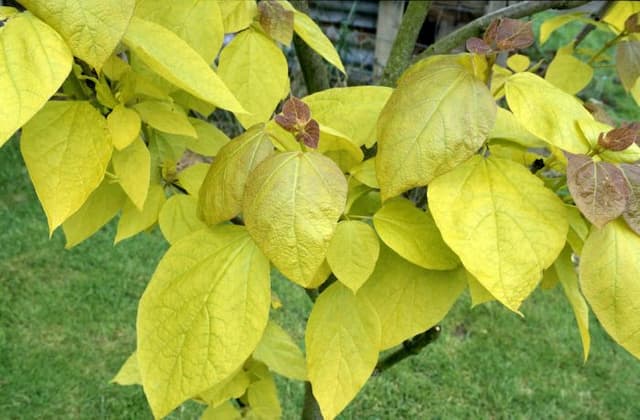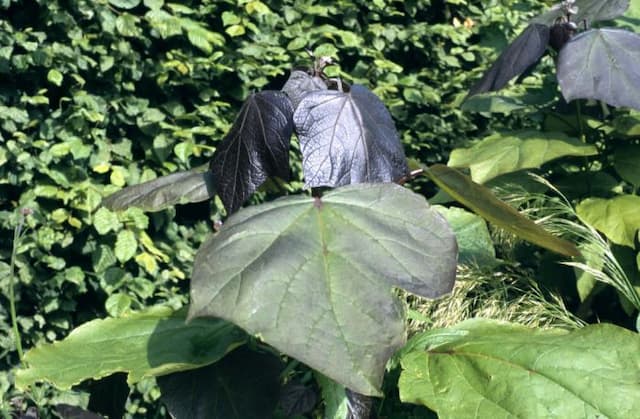Jacaranda Jacaranda mimosifolia

ABOUT
The Jacaranda, known for its stunning floral display, is a visually striking plant. It boasts an open, spreading canopy that holds a multitude of fine, feathery leaves, which give it a delicate, fern-like appearance from afar. The foliage is typically bright green, offering a lush aesthetic throughout the year. One of the most distinctive features of the Jacaranda is its spectacular flowering habit. In the blooming season, the tree is adorned with clusters of vivid purple-blue trumpet-shaped flowers. These blossoms appear in great profusion, often covering the tree so densely that the foliage is almost completely obscured, creating a breathtakingly beautiful natural spectacle. The flowers not only create a stunning visual impact but also attract a range of pollinators, adding to the tree's ecological value. Following the flowering period, the Jacaranda produces woody seed pods that are initially green and then turn to a dark brown as they mature. These seed pods can remain on the branches for quite some time, even after the leaves have dropped. The bark of the Jacaranda is relatively thin and greyish-brown in color, with a smooth to slightly textured surface that may become more furrowed as the plant ages. In areas where they thrive, Jacarandas are often used as ornamental features in avenues, parks, and large gardens, offering shade and visual appeal with their stunning canopy of purple flowers. Their elegant and dramatic appearance makes them a favorite choice for landscape design in regions with suitable climates.
About this plant
 Names
NamesFamily
Bignoniaceae.
Synonyms
Jacaranda, Blue Jacaranda, Black Poui, Fern Tree.
Common names
Jacaranda acutifolia, Jacaranda chelonia, Jacaranda ovalifolia, Jacaranda ulei.
 Toxicity
ToxicityTo humans
The Jacaranda, a popular ornamental tree, is generally not considered toxic to humans. There is no significant evidence to suggest that ingestion of its parts, such as leaves or flowers, causes poisoning in humans. However, as with any plant material, individual allergic reactions or sensitivities can occur, so it is advisable to avoid ingesting plant parts without proper knowledge of their edibility and potential effects.
To pets
The Jacaranda is not listed as a toxic plant to pets, which includes both dogs and cats. There are no widely recognized symptoms of poisoning associated with the ingestion of parts of the Jacaranda by pets. However, as with any non-food item, ingestion in large quantities could potentially lead to gastrointestinal upset or blockage. Pet owners should always monitor their animals to prevent them from eating large amounts of any non-dietary plant material.
 Characteristics
CharacteristicsLife cycle
Perennials
Foliage type
Deciduous
Color of leaves
Green
Flower color
Purple
Height
25-50 feet (7.6-15.2 meters)
Spread
15-30 feet (4.6-9.1 meters)
Plant type
Tree
Hardiness zones
9
Native area
South America
Benefits
 General Benefits
General Benefits- Ornamental Beauty: Jacaranda is renowned for its stunning display of purple blooms that create a spectacular visual impact in landscapes.
- Shade Provider: Its broad canopy offers generous shade, making it an ideal tree for parks and wide avenues.
- Habitat for Wildlife: Birds and bees are attracted to Jacaranda trees, which helps support local ecosystems.
- Urban Tolerant: Jacaranda can cope with urban conditions like pollution and poor soil, making it suitable for city planting.
- Seasonal Interest: Besides the spring bloom, it provides seasonal color changes adding year-round interest to its environment.
- Erosion Control: The tree’s extensive root system can help stabilize soil and prevent erosion.
- Drought Resistance: Once established, Jacaranda trees are relatively resistant to short periods of drought.
- Educational Value: Due to its distinct characteristics, it is often used for educational purposes in botany and horticulture.
 Medical Properties
Medical PropertiesThis plant is not used for medical purposes.
 Air-purifying Qualities
Air-purifying QualitiesThis plant is not specifically known for air purifying qualities.
 Other Uses
Other Uses- The wood of the Jacaranda tree can be used for making furniture and cabinetry, as it is often a beautifully colored hardwood with a fine grain.
- Jacaranda wood shavings and sawdust can be employed in the production of mulch for gardens, providing nutrients to plants as they decompose.
- The tree's dried seed pods can be utilized in craft projects, such as for making decorative wreaths or as components in floral arrangements.
- Jacaranda flowers are sometimes used for dyeing fabric, yielding a range of blues and purples depending on the mordants used.
- Leaves from the Jacaranda can be used for composting, as they break down and enrich the soil with organic matter.
- As a fast-growing tree, Jacaranda can be planted for use in reforestation projects and to combat soil erosion in vulnerable areas.
- The Jacaranda's dense foliage provides natural shading in landscaped gardens, reducing the need for man-made shelters and energy consumption for cooling.
- The blooms of the Jacaranda can be used in apiculture, as they produce nectar that bees can turn into a unique variety of honey.
- The tree's large size and broad canopy make it an ideal candidate for creating living fences or privacy screens in large properties.
- Jacaranda branches can be used in the setup of aviaries and bird cages, providing natural perches that simulate a more authentic environment for birds.
Interesting Facts
 Feng Shui
Feng ShuiThe Jacaranda is not used in Feng Shui practice.
 Zodiac Sign Compitability
Zodiac Sign CompitabilityThe Jacaranda is not used in astrology practice.
 Plant Symbolism
Plant Symbolism- Wisdom: With its striking and expansive canopy, the Jacaranda tree often symbolizes wisdom. Its wide reach and the peaceful environment it creates can be associated with the growth of knowledge and understanding.
- Renewal: The vibrant purple blooms of the Jacaranda signal the beginning of spring in many areas, thus the tree is commonly associated with renewal and new beginnings.
- Serenity: The lush, fern-like foliage and the calming shade of blue-purple flowers provide a serene atmosphere, making the Jacaranda a symbol of tranquility and peace.
- Beauty and Uniqueness: The vividness and unique purple color of the Jacaranda flowers are often symbols of beauty and stand as a testament to the unique splendor of nature.
- Intellectual Pursuits: As Jacarandas are often found on university campuses and in educational settings, they have come to be associated with intellectual pursuits, learning, and higher education.
 Water
WaterThe Jacaranda tree should be watered deeply but infrequently to encourage deep root growth. When it's young or newly planted, water it once a week with about 5 gallons of water, unless there is sufficient rainfall. As it matures, reduce watering to every 2 to 4 weeks, depending on the climate and weather conditions. During the hot summer months, the water requirement may increase. Always allow the soil to dry out between waterings to prevent overwatering, which could lead to root rot.
 Light
LightJacaranda trees thrive in full sun, meaning at least six to eight hours of direct sunlight daily. They perform best when planted in a location that receives unfettered sunlight throughout the day. This makes an open area away from taller buildings or trees an ideal spot to ensure the tree gets sufficient light for healthy growth and blooming.
 Temperature
TemperatureJacaranda trees enjoy a warmer climate and are best suited to temperatures between 65 to 95 degrees Fahrenheit. They can survive minimum temperatures down to around 20 degrees Fahrenheit, although they might suffer some damage. The ideal temperature range would keep them in warmer zones where frosts are rare or mild.
 Pruning
PruningPrune Jacaranda trees to shape them and remove any damaged or diseased branches. The best time to prune is in the late winter before new growth starts. Young trees can be pruned lightly to encourage a strong, balanced structure, while mature trees usually only need occasional thinning. Pruning should be done no more than once a year to avoid stress to the tree.
 Cleaning
CleaningAs needed
 Soil
SoilThe best soil mix for the Jacaranda tree is well-draining soil that consists of a combination of loamy soil, sand, and organic compost to ensure adequate nutrient content and aeration. The soil pH should be slightly acidic to neutral, ideally between 6.5 and 7.5.
 Repotting
RepottingJacaranda trees, commonly known as Jacarandas, typically do not require frequent repotting. Young trees can be repotted every 2-3 years, while mature trees may only need repotting every 4-5 years to refresh the soil or accommodate root growth.
 Humidity & Misting
Humidity & MistingJacarandas prefer moderate to high humidity levels, although they are quite adaptable. They thrive best in an environment with humidity levels ranging from 40% to 70%.
 Suitable locations
Suitable locationsIndoor
Grow Jacaranda in large pots with plenty of light.
Outdoor
Plant in full sun, well-draining soil; prune to shape.
Hardiness zone
9-11 USDA
 Life cycle
Life cycleThe life of Jacaranda mimosifolia, commonly known as Jacaranda, begins with seed germination, which ideally occurs in warm, moist soil conditions. Following germination, the seedling emerges and begins to establish its root system and first leaves, moving into the vegetative growth stage where it develops its characteristic fern-like foliage and elongated branches. As it matures, it enters the flowering stage typically in spring or early summer, producing clusters of vibrant purple or blue trumpet-shaped flowers. After the flowering stage, the plant develops woody, disc-shaped seed pods, which eventually dry and release numerous winged seeds for dispersal. The tree continues to grow and can reach significant heights, often flowering annually and going through repeated cycles of growth, flowering, and seed production. Over many years, Jacaranda trees can become large, spreading trees, living several decades under suitable growing conditions.
 Propogation
PropogationPropogation time
Spring-Early Summer
Propogation: The most popular method of propagation for Jacaranda trees, also known as Blue Jacarandas or Fern Trees, is through their seeds. The best time to collect seeds is when the pods on the tree have dried, which typically occurs in late fall or winter. To propagate Jacarandas from seeds, one must first extract the seeds from the pods and then sow them in a well-drained seed starting mix. Seeds should be lightly covered with the soil mix and kept consistently moist until germination, which can take several weeks. Once seedlings are large enough to handle, they can be transplanted into individual pots and eventually into the ground where they can grow into the beautiful flowering trees admired in landscapes.








